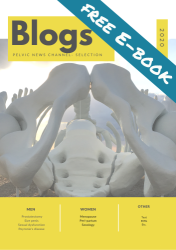In today’s blog I will discuss research on the effect of pelvic physical therapy for the treatment of dyspareunia in women who have conquered gynecological cancer. Although this research is a feasibility study, so not a randomized controlled trial with the highest level of evidence, I think it is very interesting. The pelvic physiotherapy treatment the women received consisted of multiple treatments; like education, manual therapy, pelvic floor exercises and home exercises with for instance a dilator. Although the women received twelve, one hour sessions which is a larger number of sessions with a longer duration each than what I am used to in The Netherlands (because of reimbursement), the resemblance is still substantial.
Why did they do this study?
The aim of this study was to develop a multimodal pelvic physical therapy intervention and to examine the feasibility and acceptability in gynecological cancer survivors. Besides this, the effect on within: pain, sexual function, and treatment satisfaction was also of interest.
How did they do this study?
Inclusion criteria:
- Endometrial cancer or cervical cancer (stage 1 –IV)
- No disease for at least 3 months
- Vulvovaginal pain NRS ≥5 (0 – 10) in >80% of sexual intercourse for at least 3 months
- Stable sexual partner
- Willing to try to have sexual intercourse
Exclusion criteria (full list in article):
- Painful sexual intercourse before cancer
- Other form of pelvic pain
- Other pelvic conditions like infection, chronic constipation etc.
Before starting the pelvic physical therapy treatment the eligible women were assessed by a gynecologic oncologist to check if there is no other health condition that could cause the dyspareunia.
Pelvic physical therapy intervention:
Education on for instance: pathophysiology of dyspareunia, hygiene, chronic pain, and relaxation techniques.
Manual therapy techniques like stretching, myofascial release and triggerpoint release.
Pelvic floor muscle exercises with biofeedback with the aim to normalize pelvic floor muscle function.
Home exercises were within: breathing exercises as well as pelvic floor muscle exercises, insertion exercises with a dilator (3 times per week)
(full intervention is described in appendix original article)
What did they find/ results?
31 women were included.
Feasibility: although a very extensive inclusion method was used, inclusion was very slow. The adherence to the home exercises (pelvic floor muscle and dilation exercises) was high with 93% and 83% respectively.
Treatment effects:
- Pain intensity (NRS) – p=0.001 (baseline=7.3, post-treatment=1.7)
- Sexual functioning (female sexual function index-FSFI); all domains significant improvement p=.001 (Desire p=.001, arousal p=.040, lubrication p=.017, orgasm p=.044, satisfaction p=.001, pain p=.001)
- Frequency of vaginal penetration changed from an average of 1.4 to 3.0 per month (p=.001).
- Treatment satisfaction: average=9.3 (0-10)
What does this mean for clinical practice?
Over a 3 year inclusion period health care providers referred 10 potential eligible participants. Fortunately, the researchers used multiple ways to recruit women. They also advertised in newspapers and in public health care facilities resulting in 7 potential participants. The most successful was an opt-out strategy allowing the researchers to contact women who did not actively decline to be contacted.
With an eye on the inclusion flow diagram I wonder if the inclusion numbers above are an indication that questions regarding sexual functioning are not standardized and maybe therefore forgotten to be asked by health care professionals but above all that women need to be asked specifically because few seek help by themselves.
The main message for us pelvic physical therapist is that this study, although not of the highest level of evidence, shows that pelvic physical therapy treatment of gynecological cancer survivors has good results with high treatment satisfaction. But it also shows us that we need to inform women about this treatment option and above all that questions regarding sexual wellbeing need to be addressed by health care providers because women tend to not discuss this topic by themselves!
I look forward to a randomized controlled trial on this topic with also longer term follow-up and a sub analysis to see if the treatment modality women received for their cancer (for instance: brachytherapy, radiation therapy and/or chemotherapy) influences the results.
You might also like these blogs:
- Lifelong vaginismus |fantastic results with exposure therapy
- vestibulynia | physical therapy is best treatment
Reference:
M.P. Cyr, C. Dumoulin, P. Besettte, et al. Feasibility, acceptability and effects of multimodal pelvic floor physical therapy for gynecological cancer survivors suffering from painful sexual intercourse: A multicentre prospective interventional study, Gynecologic Oncology, 2020 Sep 30;S0090-8258(20)33856-7.doi: 10.1016/j.ygyno.2020.09.001.









As every time you review an article: I really like it. Very clear and I want to give you a thumb up for this!
Thank you very much.